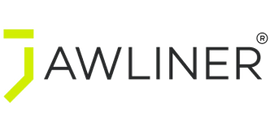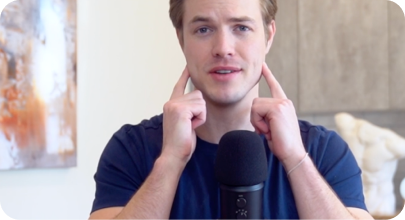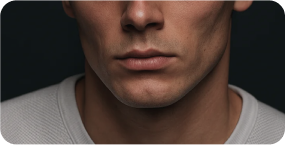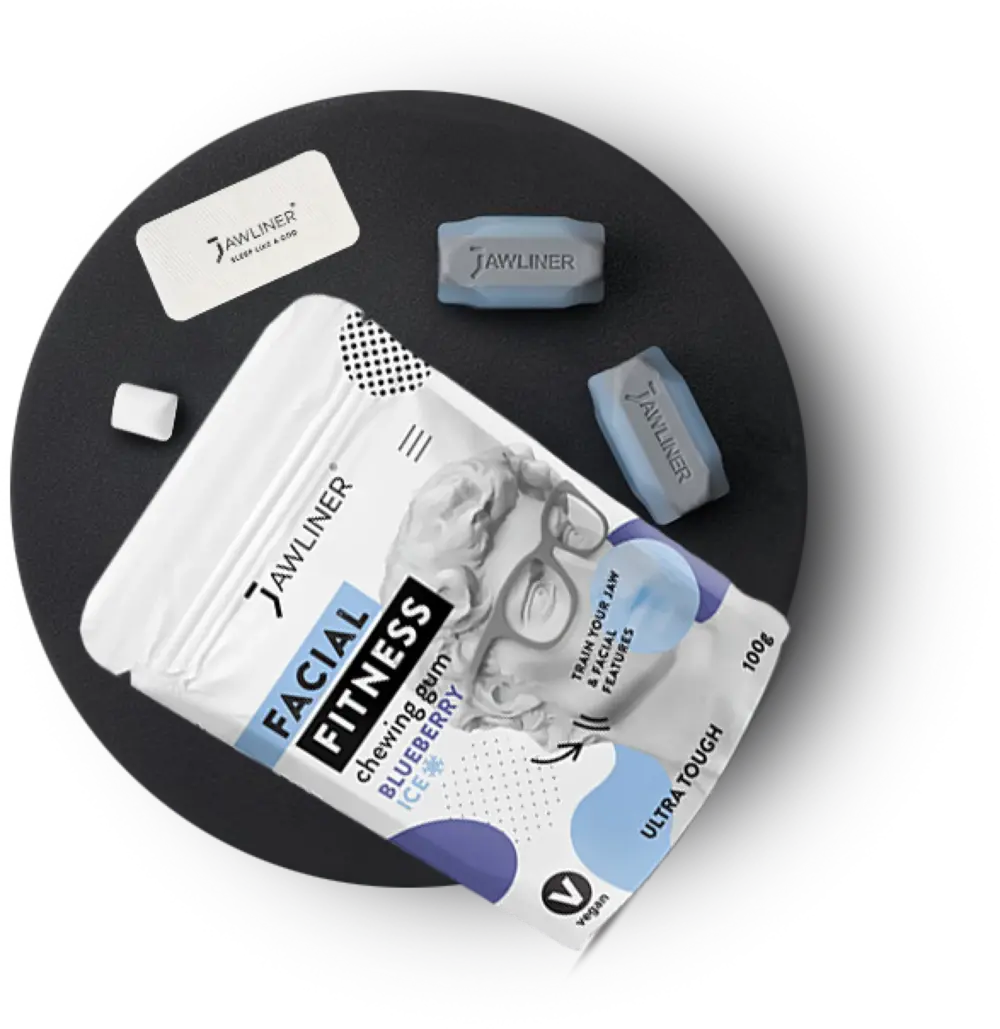Fewer wrinkles, more radiance, a sharper profile? Training your facial muscles might be just the solution. Here you’ll find out whether you can naturally shape and define your face through training, techniques, and helpful tools.
Why You Should Know More About Your Facial Muscles
If you understand your facial expressions, you can work with them more effectively. Over 20 individual muscles in the face work together. Many of these belong to the so-called mimetic musculature. These muscle groups control our expressions and reflect emotions, stress, or even (unintended ;)) fatigue.
Especially active are:
- musculus orbicularis oris (around the mouth),
- orbicularis oculi (around the eyes)
- levator labii superioris, which lifts your upper lip.
They all shape how you appear—often unconsciously. But what happens when these facial muscles are constantly tense? Stress, screen time, and lack of movement quickly lead to tense facial musculature. This is where targeted training comes in: It not only activates the muscles but—just as importantly—provides relaxation as well.
Muscle Over Scalpel – What Facial Training Can Really Do
When thinking of firm skin, people often think of expensive creams or cosmetic surgery. But there’s a more natural option: facial training can help stimulate tissue, boost circulation, and reduce early signs of wrinkles—without a scalpel.
The difference: a classic anti-aging effect targets skin tightening, while training focuses on muscle activity. The mimetic muscles are specifically engaged and kept moving. This can also positively impact your facial skin.
Note: Training does not replace a facelift. But it can help your face look more awake, vibrant, and lively. Especially with regular practice. Personal stories and “facial muscles before and after” photos show what’s possible. Results vary, of course—but one principle remains: activity brings change!
Key Muscles in the Face and How to Activate Them
Many small muscles work together in the face. They control your expressions and shape how alert, friendly, or tense you appear. Knowing which muscle groups are active where allows you to perform targeted facial training.
Mouth & Lips:
- Musculus orbicularis oris: Encircles the mouth and is responsible for closing the lips and movements like kissing, sucking, or whistling.
- Levator labii superioris: Lifts the upper lip and is involved in baring teeth and subtle smiling.
- Levator labii superioris alaeque nasi: Also lifts the nasal wing, visible when scrunching the nose.
Eyes & Eyelids:
- Musculus orbicularis oculi: Surrounds the eye, active when blinking and laughing. Weak tension can lead to eye bags or puffy eyes.
Forehead & Temples:
- Venter frontalis: Lifts the forehead skin and eyebrows; active when surprised or raising the brows.
- Musculus temporoparietalis: Assists with movements around the ear and temple area.
Jaw & Chewing Muscles:
- Musculus masseter: One of the strongest muscles in the body. It closes the jaw, runs along the outer lower jaw, and shapes the jawline. Targeted training (e.g., with Jawline Gum) can increase its volume, making the jawline appear more defined and attractive.
- Musculus temporalis: Located at the temples, works with the masseter in chewing and biting. It also contributes to facial shape.
- Musculus pterygoideus medialis & lateralis: These deeper muscles move the jaw forward and sideways. Essential for chewing motions and lateral jaw movement, they ensure balance in the jaw system.

Scalp & Fascial Layer:
- Galea aponeurotica: A tendon plate between the forehead and back of the head that influences tension in the upper facial area.
Effective Methods to Train Your Facial Muscles
Targeted facial muscle training works—provided you know how. Here are three facial exercises you can easily integrate into your daily routine.
1. Face Yoga – No Equipment, Big Impact
Face yoga—also known as facial yoga—is one of the most popular methods. It requires no tools and combines activation with conscious relaxation.
Through controlled movements, you strengthen the mimetic muscles around the eyes, cheeks, forehead, and mouth. At the same time, you can consciously shape your facial expression and release stress-related tension.
2. Resistance Training with the JAWLINER® 3.0 – Targeted Muscle Building for Your Jawline
If you want to train your masseter muscle intensively and effectively, the JAWLINER® 3.0 is the perfect solution. This specially designed tool offers real resistance—much more effective than regular chewing—and seriously challenges your chewing muscles.
Training regularly with the JAWLINER can help strengthen your jaw profile, train your cheek muscles, and make your jawline look more defined.
Important: The tool doesn’t replace a diet. A double chin won’t vanish through muscle training alone. But targeted resistance can visibly improve muscle tone and make the jaw area appear much more sculpted. See for yourself!

3. Isometric Exercises & Manual Techniques – Small Movements, Big Results
Isometric training means: tension without visible movement. Examples include holding a “smile,” pressing lips together, or pushing the jaw against your hand.
Also, targeted massage techniques can be applied—especially for sagging neck areas, sometimes called the “turkey neck.”
Training Is Good – Relaxation Might Be Even Better?
Many people unconsciously carry tension in their face, especially in the forehead, jaw, and around the eyes. Stress, screen time, or teeth grinding lead to a permanently activated muscle tone, which overburdens your facial muscles in the long run.
Here, targeted facial relaxation helps. A simple exercise is the so-called “Lion’s Face”: Open your mouth wide, stick out your tongue, and consciously tense your entire face. Then let go—an astonishingly liberating effect.
Gentle finger-tip massages also help release tension and improve circulation. If you combine training with relaxation, you can achieve more than just visible results—you’ll improve your overall body awareness.
Before and After: What’s Realistic and What’s Not
Many images online labeled “Face Yoga before and after” show impressive changes. But what’s actually realistic? Important to know: muscle gain is not the same as fat loss. Even the best training won’t melt fat deposits directly—especially not a double chin, which is usually related to body fat percentage.
The most effective way to lose fat is a caloric deficit through diet and exercise. Facial training can visibly strengthen your muscles and give your face a broader, sharper look—but it’s not a substitute for a dietary change.
Results depend on many factors: skin type, age, stress levels, posture, genetic predisposition. What really helps: consistent training and patience. Facial muscles can be activated and strengthened—so stick with it. The results become especially visible when combined with a healthy lifestyle and mindful nutrition.
By consciously working with your expressions, posture, and facial muscles, you can gradually develop a more vital appearance. Step by step—not overnight—is the key to success.
Conclusion – Your Face Can Do More Than You Think
Your facial muscles function like any other muscle: Use them, and you’ll see results.
With the right training routine, you can make visible changes to your face. If you regularly activate and relax your muscles, you’ll have the best chance to sharpen your profile, highlight your jawline, and release visible tension.
The JAWLINER® 3.0 supports you: simple, effective, and suitable for everyday use. Get started and watch what happens when you stay consistent.
FAQ – Frequently Asked Questions About Training Facial Muscles
How often should you train facial muscles to see results?
Ideally, you train 3–5 times a week for about 10–15 minutes. First changes in muscle tone or expression can appear after just a few weeks—depending on consistency, genetics, and lifestyle.
Can I train my facial muscles casually during the day?
Yes, many exercises can be easily integrated into daily activities—while working, walking, or watching TV—e.g., chewing resistance gum or holding an isometric smile. Just be sure to train consciously and with control.
Are there any risks in facial muscle training?
When done correctly, facial training is safe. Overdoing it, applying too much resistance, or using incorrect techniques can cause tension or improper strain. Always pay attention to proper form.
Is facial training suitable for women?
Absolutely. The goal is not a masculine look, but rather a more defined, vibrant appearance. Women also benefit from increased muscle tone and targeted relaxation in the face.
At what age is facial muscle training worthwhile?
Basically at any age. Ideally from your mid-20s, when natural skin elasticity starts to decline. But even later, regular training can help activate expression and make your face look more awake.
Can I combine facial training with skincare?
Yes—and it’s actually recommended. Well-circulated muscles improve the absorption of skincare products. Best approach: cleanse your face first, then train, and apply skincare afterward.
What’s the difference between Face Yoga and Jawline Training?
Face Yoga targets the entire face, including the forehead, eyes, and cheeks. Jawline Training focuses specifically on the chewing muscles, especially the masseter, and is ideal if you want to emphasize your jawline.






